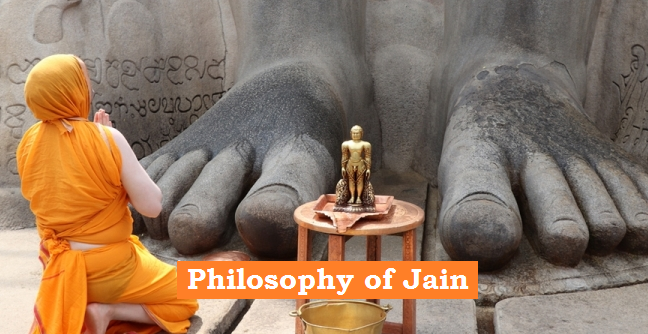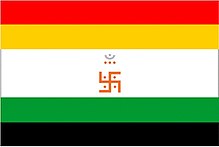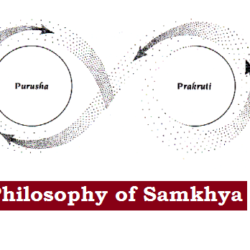
Read about Jainism here.
| Jain= jina meaning conqueror |
| Meaning: one who has conquered one’s inner enemies (passions) |

Jain Philosophy is one of the Nastika or Heterodox Schools of Indian philosophy. Jain thought is primarily concerned with understanding the nature of living beings, how these beings are bound by Karma and how they get liberated (Moksha) from the cycle of re-birth.
One of the main features of Jain philosophy is its dualistic metaphysics, which holds that there are two distinct categories of existence, the living (Jiva) and the non-living (Ajiva). It puts great emphasis on the practice of good life and non-injury to loving beings. The aphorism which has been accepted as the motto of Jainism:
Parasparopagraho Jivanam
It stresses the philosophy of non-violence and ecological harmony on which the Jain ethics and doctrines- especially the doctrines of Ahimsa and Anekantavada are based.
According to Jaina, the ultimate good for a living being (Jiva) is liberation from the cyclical world of reincarnation (Samsara) through perfect and complete knowledge (Tri Ratna) of all things.
24 Tirthankars:
According to its traditions, the teachings of Jainism are eternal, and hence have no founder. They believe in 24 Tirthankars or ‘Founders of the Faith’ through whom their faith has come down from antiquity. The Jainism of this age can be traced back to the 24th Tirthankar- Mahavira of the sixth century BC who was a contemporary of the Buddha.
Like those of the Buddha, Mahavira’s doctrines were formulated as a reaction to and rejection of Brahmanism (a religion based on the Hindu scriptures, the Vedas and Upanishads) which was then taking shape. Therefore, it is a Nastika or Heterodox Schools of Indian philosophy.
Nature of Jiva
Jainism believes that the universe is composed of two main kinds of substances, the Jiva (living) and the Ajiva (non-living). These are un-created existents which are always interacting with each other. These substances behave according to natural laws and the intrinsic nature of a substance.
The universe functions through the interaction of living souls and the five categories of non-living entities:
- Ether (Akasha)
- Means or condition of movement (Dharma)
- Means or condition of rest (Adharma)
- Time (Kala)
- Matter (Pudgala)
Characteristics of Jiva:
- Consciousness in Jiva: Jiva is generally the same as the Soul or Atman or the Purusha and Consciousness (Chaitanya) is the essence of the soul. It is always present in the soul, though its nature and degree may vary.
- Jiva is different from the body: The Jiva is not infinite but co-extensive with the body, as it can immediately know objects only within the body. Consciousness is not present everywhere but only in the body. However, it is different from the body.
- Jiva is eternal: The soul is naturally bright, all-knowing, and blissful. It is the soul that knows things, performs activities, enjoys pleasures, suffers pains, and illumines it and other objects. The soul is eternal, but it also undergoes a change of states.
- Infinite number of Jiva: There are an infinite number of souls in the universe; all fundamentally equal, but differing owing to the adherence of matter in a fine atomic form.
- Karma and Jiva: Karma adheres to the soul as result of activity. Transmigration can only be escaped by dispelling the Karma already adhering to the soul and by ensuring that no more is acquired.
- The annihilation (Nirjara) of Karma comes about through penance, and the prevention (Samvara) of the influx (Asrava) and fixation (Bandha) of Karma in the soul is ensured by carefully disciplined conduct, as a result of which it does not enter in dangerous quantities and is dispersed immediately.
- When the soul has finally set itself free, it raises at once to the top the universe where it remains in inactive omniscient bliss through all eternity. This is Nirvana (liberation).
- Jivas are categorized into two types- liberated and non-liberated. A liberated Jiva is free from Karma and enjoys essential qualities like knowledge, consciousness and bliss (sukha), etc. But obscured by Karma in the case of non-liberated souls resulting in karmic bondage.
Epistemology: Study of Knowledge (Jnana)
Means of Knowledge:
Jain Philosophy accepts three reliable means of knowledge (Pramana):
- Perception (Pratyaksa)
- Inference (Anumana)
- Testimony (Sabda).
Types of knowledge:
According to Jain Philosophy, knowledge is of five kinds:
- Kevala Jnana (Omniscience)
- Srutu Jnana (Scriptural Knowledge)
- Mati Jnana (Sensory Knowledge)
- Avadhi Jnana (Clairvoyance)
- Manah prayaya Jnana (Telepathy)
The first two are described as being indirect means of knowledge (Parokhsa), with the others furnishing direct knowledge (Pratyaksha), by which it is meant that the object is known directly by the soul.
Tri-Ratna (also Ratna Treya): Liberation through knowledge

According to Jaina, the ultimate good for a living being (Jiva) is liberation from the cyclical world of reincarnation (Samsara) through perfect and complete knowledge (Tri Ratna)of all things. Those who have such knowledge are ‘Kevalin’ (enlightened). This is the sum and substance of Jain’s idea of human destiny.
Without any rituals, Jainism lays down a definitive course of practical moral discipline, contemplation of the highest truth, and reorientation of life in light of these for attaining ultimate reality or truth, collectively called Tri-Ratna or Ratna-Traya (Three Jewels).
- Right perception (Samyak Darsana): seeing based on true knowledge of the Tattvas (substances, realities). Right vision is attained by right knowledge. From the practical point of view, it means to have a total faith in the preaching of Tirthankaras, and their scriptures known as Agams.
- Right knowledge (Samyak Jnana): knowing the Tattvas such as the Jivas (living beings) as they truly are. It is based on comprehensive apprehension of reality in multitude of view points and relativity- doctrines of Anekantvada , Syadvada and Nayavada provides multiple viewpoints. From practical purpose, it means to accept the diversity and opposing views.
- Right conduct (Samyak Charitrya): following a strict code of conduct (including Panchmahavrat) by application of right vision and right knowledge. For practical purposes, one has to follow ethical codes, rules, and disciplines.
The three jewels, if cultivated together will ensure liberation. But if each of the three is practiced in isolation from the other two, it will cause conflicts or tensions. Individually, they are incomplete and insufficient because they are mutually dependent with one another.
Nature of knowledge: Relativity and Pluralism
Jainism includes three related doctrines which deal with the complex and manifold nature of knowledge: Anekantavada (the theory of many standpoints), Syadvada (the theory of conditioned predication) and Nayavada (the theory of partial standpoints).
Anekantavada:
- Reality is complex and multi-faceted and therefore can only be understood from a multiplicity of perspectives.
- As all existent entities have infinite attributes, many standpoints can be used to describe a substance.
- This doctrine is often illustrated through the parable of the “blind men and an elephant”. In this story, each blind man felt a different part of an elephant and then claimed to understand the true appearance of the elephant, but could only partly succeed.
- According to the Jains, only the Kevalis (omniscient beings) can comprehend objects in all aspects and manifestations.
- Anekantavada encourages its adherents to consider the views and beliefs of their rivals and opposing parties and has influenced Gandhi to adopt principles of religious tolerance, Ahimsa and Satyagraha.
Syadvada:
- As reality is complex, no single proposition can express the nature of reality fully. Thus the term Syad (may be) should be prefixed before each proposition giving it a conditional point of view and thus removing any dogmatism in the statement as well as indicating that the sentence is true only from a specific point of view.
- Since it ensures that each statement is expressed from seven different conditional and relative propositions, it is also known as Saptibhanginaya or the theory of seven conditioned predications.
- This sevenfold analysis is seen by Jain philosophers as being universally applicable and to be exhaustive of the possible truth-values that a given proposition can convey.
| Saptibhangi |
| 1. Arguably, it (that is, some object) exists 2. Arguably, it does not exist 3. Arguably, it exists; arguably, it doesn’t exist 4. Arguably, it is non-assertible 5. Arguably, it exists; arguably, it is non-assertible 6. Arguably, it doesn’t exist; arguably, it is non-assertible 7. Arguably, it exists; arguably, it doesn’t exist; arguably it is non-assertible |
Nayavada:
- As reality is complex, no single proposition can express the nature of reality fully. Jain philosophers use the theory of partial viewpoints in order to explain the complexity of reality, part by part.
- As an object has infinite aspects to it, but when we describe an object in practice, we speak of only relevant aspects and ignore irrelevant ones.
- It holds that all philosophical disputes arise out of confusion of standpoints. Jain literature lists seven partial viewpoints.
- According to Jain philosophers, other philosophical systems rely on only one of the seven standpoints, while excluding the others. This is explains why they have reached false conclusions. For example, Vedanta relies with the second naya (generic view) and Materialism with the third naya (pragmatic view). Jainism is seen as the only philosophy able to combine all seven nayas.
| Nayavada |
| 1. Common view: how an entity is generally perceived (‘common sense’) 2. Generic view: seeks to classify the entity 3. Pragmatic view: assesses the entity in terms of its possible uses 4. Linear view: looks at the entity as it is in the present moment 5. Verbal view: seeks to name the entity 6. Etymological view: uses this name and its relations with other words to discern its nature 7. Actuality view: concerned with the concrete particulars of the entity |
Jain Ethics: Mahapanch Vrata
Emerging from Ratna-Treya (Three Jewels) and relating to right conduct a strict ‘code of conduct’ is prescribed in Jainism, not so much for the sake of morality as the path to liberation. In fact, Jainism views religion merely as a science of ethical practice. It conceives the human body as a chariot on which the soul rides towards liberation.
Jainism teaches five ethical duties, which it calls Mahapanch Vrata (Five Great Vows). These come in two main forms, the Anuvratas (Minor Vows) for Jain laypersons, and Mahavratas (Great Vows) for Jain monks. The Sanskrit word ‘Vrata’ is derived from ‘vri’ meaning ‘to select or choose.’
They are the following:
- Nonviolence (Ahimsa): not to cause harm to any life form.
- Truthfulness (Satya): to speak the harmless truth only
- Non-stealing (Asteya): not to take anything not properly given
- Chastity (Brahmacharya): not to indulge in sensual pleasure
- Non-attachment (Aparigraha): complete detachment from people, places, and material things.

 Home
Home Syllabus
Syllabus Contact Us
Contact Us








